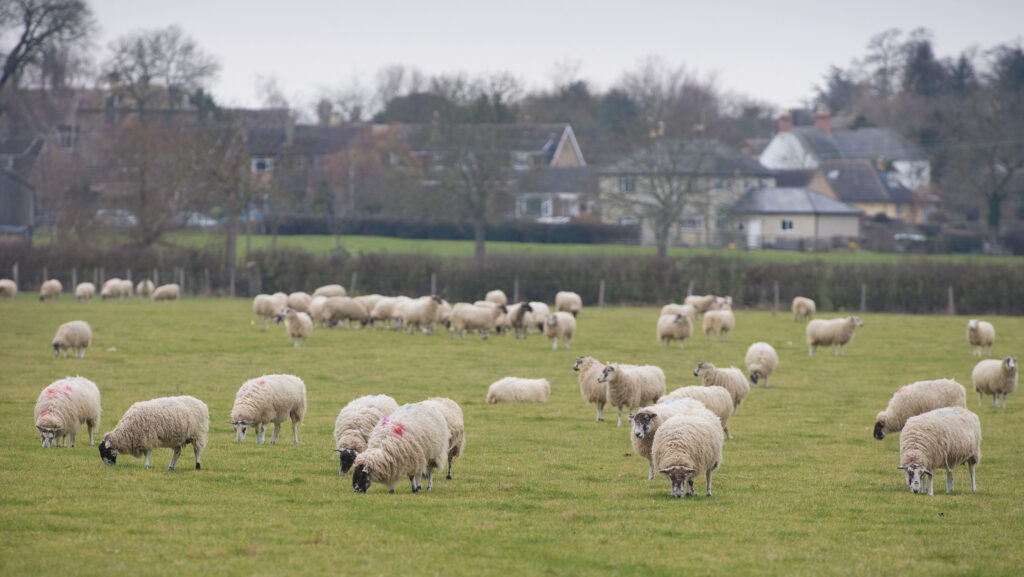20 tips for lambing from award-winning sheep farmers
 © Tim Scrivener
© Tim Scrivener Each year, the UK sheep industry lambs 15m breeding ewes in a huge variety of systems and locations. From sea level to hill top, they lamb in every month of the year.
“Out-of-season” breeds might opt for an autumn crop, while hill flocks lamb in May and June.
Farmers Weekly spoke to to two past Sheep Farmer of the Year winners – one, an indoor lamber, the other, outdoor – to get their tricks of the trade.
See also: Step-by-step guide to dealing with vaginal prolapse in sheep
Annie Carr, The Brays, Bosbury, Herefordshire

Annie Carr © Richard Stanton
Lambing system
- Lambing a flying flock of 420 ewes
- Ewes housed for four months and fed analysed silage and ewe rolls
- Three-week lambing period
- Lambing done by Annie and her mother Emma.
Herefordshire sheep farmer Annie Carr has achieved a mortality rate of 3% in recent years from scanning to sale in her indoor lambing system.
This means she can sell 180% from her flying flock of Romney and Aberfield cross EasyDam ewes.
Ewes are shorn twice a year – once at January scanning and a second time at weaning in August – and start lambing on 26 March.
Below, Annie shares her tips:
1. Physically suckle lambs onto ewes to ensure colostrum provision
Every ewe that lambs is turned onto her back and lambs placed onto the teats. Annie watches until they have sucked.
This job can take up to five minutes, but it saves time on checking lambs and making supplementary colostrum.
2. Set a sleep routine and stick to it
Annie knows that following a routine is better for health and concentration. She is very strict on her two, two-hour periods of sleep (8-10pm and 1am-3am) during lambing.
Ewes are fed twice daily at 8am and 5pm so that most ewes lamb at either daybreak or just before midnight.
3. Have a low ewe-to-pen ratio
There are 85-90 pens for 420 ewes, meaning each pen is only used four to five times during the lambing season, which helps with hygiene.
Each pen is mucked out, left to dry and covered in lime between each use. After lambing, the painted and galvanised hurdles are pressure-washed with water and disinfectant.
4. Eat properly
Annie and her mother batch-cook meals for when they are busy lambing. Annie believes having proper meals at normal times is better for health, which in turn helps make better decisions.
5. Use a whiteboard
This can be used to clearly write down any problems, numbers for turning out, kilogrammes of concentrate fed and so on. It means jobs still get done if Annie is resting or out checking fields.
6. Highlight individual pens
A system for marking individual pens ensures problems are clearly shown.
Tying feed bags onto hurdles is one simple way, and a little plastic board can show which pens need extra attention due to fostering or difficult lambings.
7. Make cleaning easy
If cleaning is kept simple, it will get done. Annie makes sure there is room between individual pens for a wheelbarrow, for easy feeding and mucking out.
8. Protect hands
Clean hands are better for both shepherd and sheep. Having a good supply of hot water, paper towels, antimicrobial skin cleanser and hand cream helps.
9. Watch hygiene when fostering
When wet fostering, catching as much fluid as possible onto a tray or feed bag at lambing prevents contamination of the bedding.
10. Sterilise feeding tubes
Annie uses sterilising tablets to clean stomach tubes and teats.
11. Group pet lambs
Keeping bottle-fed lambs in small groups of similar ages helps to identify the strong and weaker performers and means they all hit their five-week weaning age at the same time.
12. Save your back
A crook is useful for grabbing ewes, while a double-ended crook (Kiwi crook) can catch feet or heads.
Andy Wear and Jen Hunter, Fernhill Farm, Compton Martin, Somerset

Andy and Jen Wear © Kathy Horniblow
Lambing system
- 1,200 ewes lambed outside
- 1,000 ewes bred to Romney and 200 to lustre breeds such as those based on Teeswater and Wensleydale
- Ewes tupped in three to five groups each year for 24-28 days
- Labour requirement is Andy, Jen and a Bristol University student vet.
Delaying lambing by three weeks until grass and clover are growing has saved drift lambers Andy and Jen Wear a 10t feed bill.
Producing sheep on grass alone is at the heart of a farming system based on working as closely with nature as possible on the Mendips.
Lambing from mid-April, sheep are checked twice a day (6-8am and 6-8pm) in a drift lambing system that moves ewes daily from 0.5ha (1.2-acre) paddocks. Most fields are 4-6ha (10-15 acres).
The system is seeing good flock health results, with flock antibiotics use well below the Responsible Use of Medicines in Agriculture target of 20mg/kg, at 5.57mg/kg, as calculated by Langford Vets.
Their tips include:
1. Use all the senses
On arrival at a lambing field, Andy and Jen stop, turn any engines off, and take in what is around them.
Taking a moment to look for signs of predators or any patterns in the flock’s behaviour, and listening out for any ewes in distress, saves time in the long run.
2. Promote bonding through natural diets
Having the right kind of sheep on the right ground and relying on spring grass alone means feed from bags and snackers does not disrupt sheep or give them subacute ruminal acidosis.
This means less chance of mismothering.
3. Shear in winter
Andy blade-shears the ewes six weeks pre-lambing to reduce the weight they are carrying.
This also makes it easy to see any lambing or suckling issues from 100m away, saving time and reducing the need for intervention, while also giving lambs easier access to teats.
4. Remove time-sapping genetics
Andy and Jen mark and remove from the breeding programme any ewe that needs help lambing or suckling its lambs.
5. Plan lambing around colostrum
Ewes must be in good condition to milk well and produce good colostrum. Food tubs are filled with 150-200ml of colostrum, which is frozen, then thawed as needed.
6. Be prepared for issues
Andy carries a piece of string in a rucksack (along with iodine and spray marker, and a chocolate bar for his own energy levels).
The string can be used to tie a ewe up if she is trying to abandon her lamb.
7. Set up hospital pens
A basic pen in a sheltered corner and a spare gate for catching ewes is useful to deal with problems such as dopey lambs after a slow lambing or a flighty ewe.
8. Classify interventions to reduce drug use
To reduce wasting single-use plastic, disposable gloves are generally not used, so lambing interventions are categorised to manage antibiotics use.
Lambs only requiring a gentle pull or a slight intervention in the birth canal are deemed not to require an antibiotic.
Instances where the full hand is inserted are deemed to require a non-steroidal anti-inflammatory and a dose of antibiotic.
No more than 2% of ewes require assistance at lambing, of which half may need a hand inside them.
